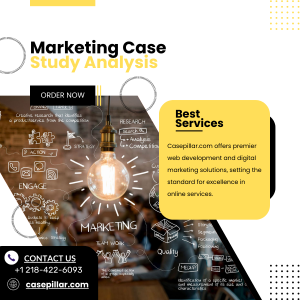Marketing Case Study Writing Help
Pay Someone To Do My Marketing Case Study
Case studies can be an invaluable asset when marketing services or products. By showing customers you can solve their problems effectively and building trust, case studies help sell services or products while driving traffic directly to your website.
Offer incentives to encourage clients to participate in your case studies, such as offering to promote their story on social media or include it in email campaigns.

Identifying the major problem
Marketing case studies are an excellent way to demonstrate the solutions your company provides customers. Case studies can take many forms, from blog posts and articles, video presentations and emails highlighting customers’ results from using your products or services. The most engaging case studies emphasize this focus while remaining authentic – creating real results through real interactions between customer and provider.
A good marketing case study should include details about the client’s issue, goals and your solution; in addition to detailing any tangible benefits such as increased sales or decreased network downtime that result from this work.
From an overall perspective, case study writing often follows an inexacting formula: you introduce your client, describe their goal and outline your solution; you then discuss results (if impressive!). But this format can become rather dull after some time; therefore it’s essential that your case study includes sensory details, frustration points and anecdotes in order to keep readers engaged throughout.
Identifying the related problem
Marketing case studies can be an excellent way to demonstrate to potential customers how your product can help them and demonstrate your understanding of customer pain points and solutions. Anyone can claim they understand an industry, but only those who can back it up with proof have true credibility.
Step one in creating a successful case study is identifying its underlying issue through surveys or interviews with client employees, so as to create an engaging story and present pertinent information more concisely to your audience. Utilize charts and visualizations where appropriate so as to add depth of content that resonates more with readers.
Once you’ve identified the issue, you can write your case study itself. Make sure it’s engaging by including plenty of facts and figures – this will keep readers engaged while increasing the chance they convert to customers. Be sure to include a call-to-action that directs readers towards pages related to their pain point(s).
Identifying the possible solutions
Evidence of your solution’s efficacy should also be presented, since consumers tend to trust businesses with proven track records. For instance, selling time management software might make more impactful claims about improving efficiency by 20% than showing one of your clients saving four hours each week with its use.
Marketing case studies can be presented in many different forms, such as blog posts, videos, social media or email messages. When choosing the format that best meets the needs of your target audience it is vital that they find value in what you present them with.
Creating the case study
Case studies can be an excellent way to attract new customers by telling the tale of one of your most successful clients. A good case study should be easy for readers to digest, with visual aids like charts and graphs for ease of comprehension, along with an obvious call-to-action that prompts the reader to book a demo or download free trials; using quotes also adds personalization and credibility to its contents.
Case studies that emphasize tangible results such as increased traffic or revenue are the best, so make sure that these outcomes are highlighted in your headline or first paragraph of your case study to help potential clients better understand your solution and assess whether it fits their needs.
Finding suitable case studies is best achieved through asking your sales team for suggestions. They should help locate customers who can act as references for your company.
Marketing Case Solution
Marketing Case Solutions are an invaluable way of showcasing products and services to prospective customers, while building trust through social proof.

First, select an appropriate topic for your case study that resonates with both your target audience and industry. Consider including quotes from clients or customers in your case study as part of its value proposition.
Read the Case Thoroughly
When writing a case study about your product or service, be sure to include details that make it stand out. For instance, if your services helped increase client sales by 200 percent, that should be highlighted as one key statistic.
One key tip when solving marketing cases is reading them through closely to gain a complete understanding of the situation more precisely.
As soon as they have reviewed all aspects of the case, he or she should identify any major problems to be solved in regards to financial condition, customer and employee satisfaction, etc.
Once the major issues have been identified, the next step should be developing alternatives and evaluating them against certain criteria; once deemed suitable, implementation will take place as the fifth crucial component of marketing case solution.
Read the Questions
Marketing case studies are powerful ways to demonstrate value, build credibility and spur action from prospective customers.
One of the key strategies marketing case solvers frequently overlook is thoroughly reading their questions. Reading all questions thoroughly is actually quite an integral part of solving marketing cases since it helps analyze them more thoroughly and understand their contents more readily.
This will also make it easier to quickly identify and solve the main issues within a case. Because most cases present multiple issues, identifying one main one and then providing more accurate analysis makes solving cases much faster and simpler, helping achieve maximum results as quickly as possible.
Identify the Major Problem
An effective case study should maintain a singular focus. While this can be challenging when exploring an entire marketing campaign, it’s essential that we keep in mind the end goal and stay true to its focus. One effective method for doing this is through employing a problem-solution structure.
ITIL Service Operation book recommends conducting a major problem review after every major incident but sometimes it can be hard to judge when something truly qualifies as major.
Identify the Learning Outcomes
Learning outcomes are specific, measurable statements that outline what knowledge and skills learners will acquire through a particular teaching experience such as a course, seminar or training session. They differ from teaching aims which describe more broadly desired results of such experiences.
Identification of learning outcomes requires careful consideration. As a starting point, consider reviewing your course or program’s learning objectives. To narrow in on key concepts and ideas more quickly, referring to a list of concrete action verbs that correspond with Bloom’s Taxonomy levels may also help.
Once you know exactly what outcomes you want students to know (cognitive), be able to do (skills), and value (affective), match each outcome with an appropriate mode of assessment. For instance, cognitive strategies requiring them to recognize key events leading up to historic events might be assessed using multiple-choice questions while outcomes that require them to compare policies could require writing an essay as assessment tools.
Marketing Case Study Analysis
Marketing case studies are one of the most efficient ways to generate leads by showing prospective clients exactly what you can offer them. Designs, depth of details, and results all play an essential part.

Start general and delve into specific details of the subject matter to allow readers to connect with your subject and understand his/her struggles.
Identifying the Problem
Locating the problem is of primary importance when solving a marketing case study, and involves reading through and understanding every element of the case study before identifying any data or information pertinent to its resolution. Additional research may also include conducting market analyses, interviewing customers or suppliers or surveying target markets.
Make sure that the problem you’ve identified is one that your target audience cares about and responds positively to, to ensure that the results of your marketing strategy have an impactful and successful result on their lives.
Unother key element of identifying a problem is identifying possible solutions. Be sure to consider how feasible or difficult it would be for your audience members to implement the recommended solution, which will allow you to select an effective marketing campaign and method of implementation.
Identifying the Solution
Identification of solutions is an integral component of case study analysis. To do so, one must evaluate different alternatives according to certain criteria – customer satisfaction, sales of company, employee morale and investment in R&D are some key metrics. Furthermore, it’s also vital that we identify root causes and effects of any problems we uncover in our analysis.
As you create solutions, make sure they address what really matters to your prospects. An effective way of doing this is targeting specific segments of your audience – for instance if your company sells shoes, purses and hats then selecting case studies which demonstrate success selling those products will create more compelling stories which resonate with prospects while increasing the chance of turning them into paying customers.
Identifying the Outcomes
Once your case study is complete, it’s time to identify and assess its outcomes. This should include outlining any obstacles encountered and how these were overcome or mitigated; additionally it would be advantageous to include quotes from satisfied customers to add credibility and authenticity.
Promoting marketing case studies via social media and email is an effective way to increase exposure and achieve results. Be sure to tailor the promotion specifically towards your target audience for maximum impact of the campaign.
An effective marketing case study can set your business apart from its competition by clearly demonstrating your product or service’s value proposition. By clearly defining the problem, analyzing solutions, and outlining outcomes of strategy you can create a captivating case study which generates leads for your product or service – such as one featuring time management software which saves a customer four hours each week can make for compelling reading – this may cause customers to trust your brand more than with competitors who don’t provide case studies like your own.
Identifying the Impact
Marketing case studies provide a powerful narrative documenting an actual business scenario and its results, providing you with information to analyze and evaluate information as well as make recommendations to management for improving operations within your organization. Furthermore, case study analyses also showcase your skills and knowledge while building credibility and trust with potential customers and clients.
Case studies can be an invaluable way to create an authentic brand that resonates with its target market, by showing how your products or services perform in real-world settings. For instance, if your company offers time management software, an effective case study demonstrating how it helped one of your clients save four hours each week would demonstrate its worth and draw new customers in. Furthermore, case studies can serve as lead magnets by including them on websites, social media accounts, email campaigns or trade publications/trade shows – you could even use them as lead magnets when trying to attract new customers!